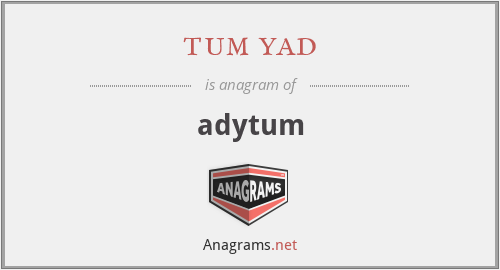What anagrams are available for adytum?
This page is about an anagram for the word tum yad that can be used in word games, puzzles, trivia and other crossword based board games.
tum yad
Translation
Find a translation for tum yad in other languages:
Select another language:
- - Select -
- 简体中文 (Chinese - Simplified)
- 繁體中文 (Chinese - Traditional)
- Español (Spanish)
- Esperanto (Esperanto)
- 日本語 (Japanese)
- Português (Portuguese)
- Deutsch (German)
- العربية (Arabic)
- Français (French)
- Русский (Russian)
- ಕನ್ನಡ (Kannada)
- 한국어 (Korean)
- עברית (Hebrew)
- Gaeilge (Irish)
- Українська (Ukrainian)
- اردو (Urdu)
- Magyar (Hungarian)
- मानक हिन्दी (Hindi)
- Indonesia (Indonesian)
- Italiano (Italian)
- தமிழ் (Tamil)
- Türkçe (Turkish)
- తెలుగు (Telugu)
- ภาษาไทย (Thai)
- Tiếng Việt (Vietnamese)
- Čeština (Czech)
- Polski (Polish)
- Bahasa Indonesia (Indonesian)
- Românește (Romanian)
- Nederlands (Dutch)
- Ελληνικά (Greek)
- Latinum (Latin)
- Svenska (Swedish)
- Dansk (Danish)
- Suomi (Finnish)
- فارسی (Persian)
- ייִדיש (Yiddish)
- հայերեն (Armenian)
- Norsk (Norwegian)
- English (English)
Definition
What does adytum mean?
- adytum
- The adyton (Ancient Greek: ἄδῠτον [ádyton], 'innermost sanctuary, shrine', lit. 'not to be entered') or adytum (Latin) was a restricted area within the cella of a Greek or Roman temple. The adyton was frequently a small area at the farthest end of the cella from the entrance: at Delphi it measured just 9 by 12 feet (2.7 by 3.7 m). The adyton often would house the cult image of the deity. Adyta were spaces reserved for oracles, priestesses, priests, or acolytes, and not for the general public. Adyta were found frequently associated with temples of Apollo, as at Didyma, Bassae, Clarus, Delos, and Delphi, although they were also said to have been natural phenomena (see the story of Nyx). Those sites often had been dedicated to deities whose worship preceded that of Apollo and may go back to prehistoric eras, such as Delphi, but who were supplanted by the time of Classical Greek culture.In modern usage, the term is sometimes extended to similar spaces in other cultural contexts, as in Egyptian temples or the Western mystery school, Builders of the Adytum. The term abaton (Koinē Greek: ἄβατον, [ábaton], 'inaccessible') or avato (Greek: άβατο, [ˈavato]) is used in the same sense in Greek Orthodox tradition, usually of the parts of monasteries accessible only to monks or only to male visitors. Truncated variants of the term, adyt or adyte (plural: adites, addittes, adyts) are found in English as early as the late 16th century. By the early 19th century, the term acquired a figurative meaning, referring to the innermost parts of any structure or of the human psyche.
Embed
Citation
Use the citation below to add this anagram to your bibliography:
Style:MLAChicagoAPA
"tum yad." Anagrams.net. STANDS4 LLC, 2024. Web. 21 May 2024. <https://www.anagrams.net/term/232302>.



Discuss this adytum anagram with the community:
Report Comment
We're doing our best to make sure our content is useful, accurate and safe.
If by any chance you spot an inappropriate comment while navigating through our website please use this form to let us know, and we'll take care of it shortly.
Attachment
You need to be logged in to favorite.
Log In